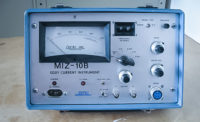
This shows an in-line testing fixture with an eddy current encircling coil designed to validate the proper heat treat process for powder metal gears. Source: Criterion NDT
Eddy current testing is a proven nondestructive test methodology well suited for finding cracks and flaws, and verifying proper heat treat conditions in metal components. Eddy current testing’s main value is providing medium- to high-volume manufacturers a way to reduce warranty and scrap costs by performing in-line testing of every part. An additional advantage is that it is a clean technology and can reduce or eliminate the need for traditional testing methodologies such as magnetic particle, dye penetrant and nital etch visual inspection.
Problems associated with magnetic particle, dye penetrant testing and nital etch include:
1. These inspections use chemicals that must be purchased, stored, handled, documented and disposed of in accordance with government guidelines.
2. Magnetic particle and dye penetrant inspection require that parts are cleaned before and after testing.
3. Magnetic particle, dye penetrant and nital etching are all visual inspections and are therefore subject to human interpretation.

To speed up testing and increase area coverage, multiple coils can be used in a single probe. This is a multi-coil eddy current crack testing probe. Source: Criterion NDT
Eddy Current Crack Testing 101
Thinking back to high school physics, an electro-magnetic field is generated by passing an electrical current through a coil of wire. If an alternating current (AC) signal is used, a fluctuating magnetic field will develop. When that AC energized coil of wire is held next to a piece of metal, the fluctuating magnetic field passes in and out of the metal very quickly, and induces an electrical current flow in the metal called eddy currents. And like the wire, those eddy currents generate a secondary magnetic field.For production testing, an eddy current instrument provides the AC signal. An eddy current probe generates the primary magnetic field. It also detects changes in the resultant secondary magnetic field created by the eddy currents in the metal.
When there is a crack or flaw in the metal, the eddy currents have to make a detour. This detour causes a change in the shape of the secondary magnetic field created by the eddy currents. When this occurs, the eddy current reading differs from that of a part without the flaw. Eddy current instruments are designed to detect the differences in eddy current flows between known good parts and parts with cracks or flaws.
Eddy current testing for cracks is a dynamic test, which means that the probe must move across the part or the part must move across the probe. To speed up testing and increase area coverage, multiple coils can be used in a single probe. Modern eddy current instruments independently analyze the data from each coil to look for flaws.
Let’s consider the typical eddy current response to a series of cracks. This test is set to run at multiple frequencies as lower frequencies penetrate further in the part and higher frequencies are better at finding small surface cracks. The alarm window is set to reject all but the smallest flaw. This alarm box is adjustable and set for each test. If a reject condition occurs, the industrial I/O in the instrument sends a signal to a PLC in the material handling system and the part is rejected.
By incorporating a properly designed in-line eddy current crack testing system, off-line testing using magnetic particle or dye penetrant testing can be eliminated. This will eliminate chemical consumption, pre-test part cleaning, post-test part washing, manpower required to run these tests, and the shop floor space taken up by the testing and demagnetization stations. Because these are off-line tests, errors found due to manufacturing process issues are harder to immediately catch and fix on the production line.

Custom heat treat probes like this spindle probe are designed for larger parts, or parts with varied heat treat patterns. Source: Criterion NDT
Eddy Current Heat Treat Testing 101
To verify proper heat treat conditions, eddy currents must be induced into the metal component under test just like in eddy current crack testing. However, heat treat testing is run as a static test where the part under test is compared to a known good set of conditions stored in the eddy current instrument. Different metallic “structures” within the material will change how the eddy currents flow into the material, which is sensed by the eddy current instrument. Sometimes eddy current heat treat testing is referred to as material structure testing.These structure differences are in many cases due to changes in heat treat conditions or alloy content. If these are different from the desired conditions, the eddy current instrument will detect the difference. When an out-of-tolerance condition is detected, the industrial I/O in the instrument sends a signal to the material handling system to reject the part.
Like the crack testing example, multi-frequency testing can find structural defects much better than a single frequency test. An eddy current instrument screen shot can show a typical heat treat test running at eight discrete frequencies. Since each component testing application is unique, an application engineer usually conducts a feasibility test to zero in on a range of frequencies that best suits the test sorting requirements. Improper selection of test frequencies may miss some heat treatment variations that are considered rejectable.

Crack test flaw responses on an eddy current instrument are shown here. Source: Criterion NDT
For larger parts, or parts with varied heat treat patterns, custom heat treat probes are designed. This probe is used to test the heat treat patterns on an automotive wheel spindle in various locations. The copper wire from the coil winding on the bottom of the probe can be seen in the Spindle Probe photo on p. 8. The stainless steel components on the probe protect the coil windings and nylon structures as well as provide positive positioning when coupled with a test part.
A cut away of the wheel spindle that goes with the probe also can be shown. Before eddy current testing was fully adopted, quality personnel would take a set of sample parts each shift. The parts would be cut and nital etched to verify proper hardness conditions such as missing heat treat, shallow case, delayed quench, short quench, air cooled and misplaced case. One major wheel bearing manufacturer has greatly reduced the time and chemicals used to test their parts since going to 100% eddy current testing. Now they only cut and etch one part per shift to validate the eddy current systems, saving hundreds of thousands of dollars.
Eddy current is a clean testing technology that can provide 100% in-line production testing, at production line speeds. In many cases it can eliminate the need for magnetic particle or dye penetrant testing for the detection of cracks and flaws. This eliminates the need for chemicals associated with these processes and the cleanup afterward. For heat treat testing, it reduces the number of parts to be testing with nital etching techniques. This also reduces chemical consumption and labor.
Tech Tips
- Eddy current is a clean testing technology that can provide 100% in-line production testing at production line speeds.- In many cases eddy current can eliminate the need for magnetic particle or dye penetrant testing for the detection of cracks and flaws.
- Eddy current eliminates the need for chemicals associated with these processes and the cleanup afterward.

